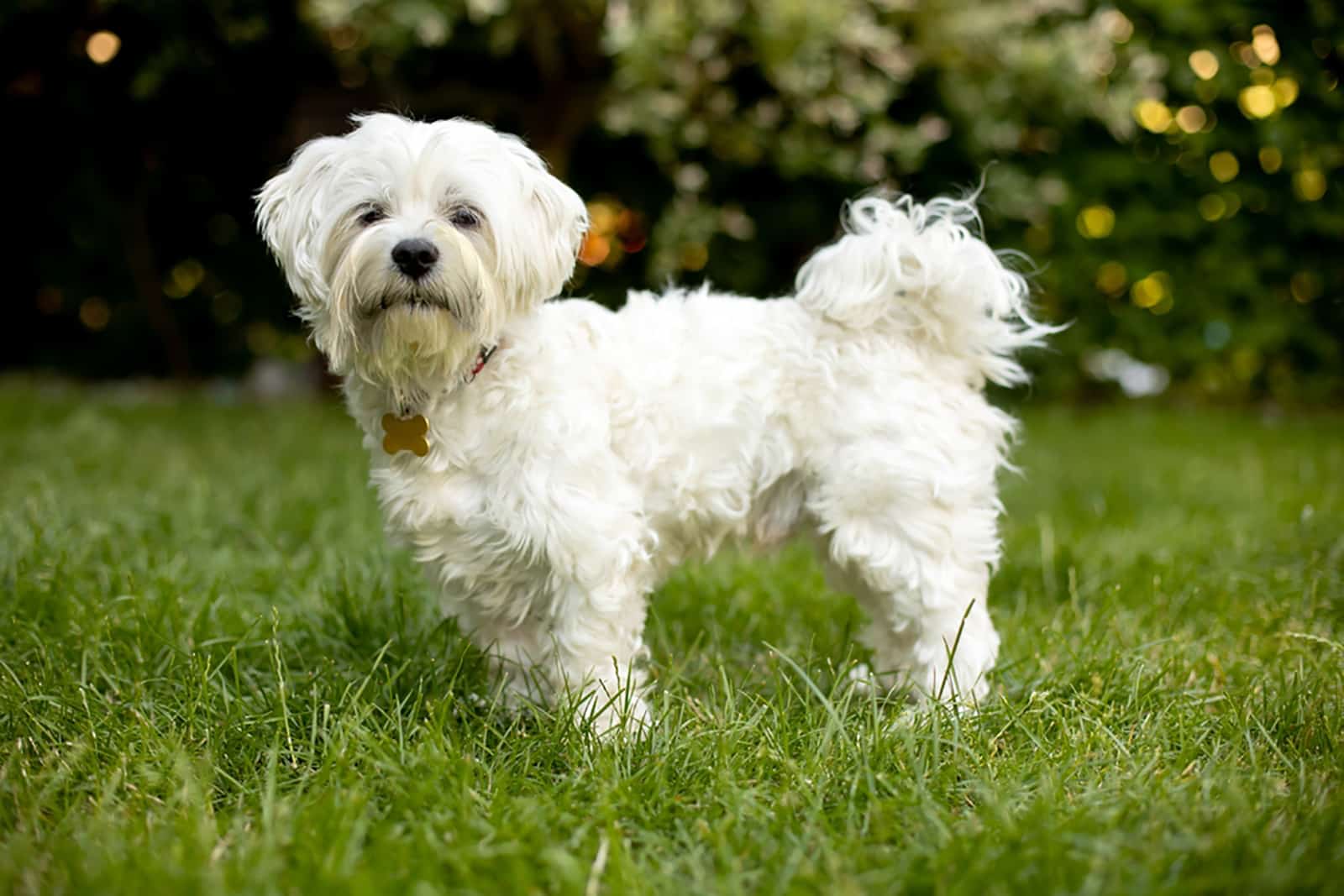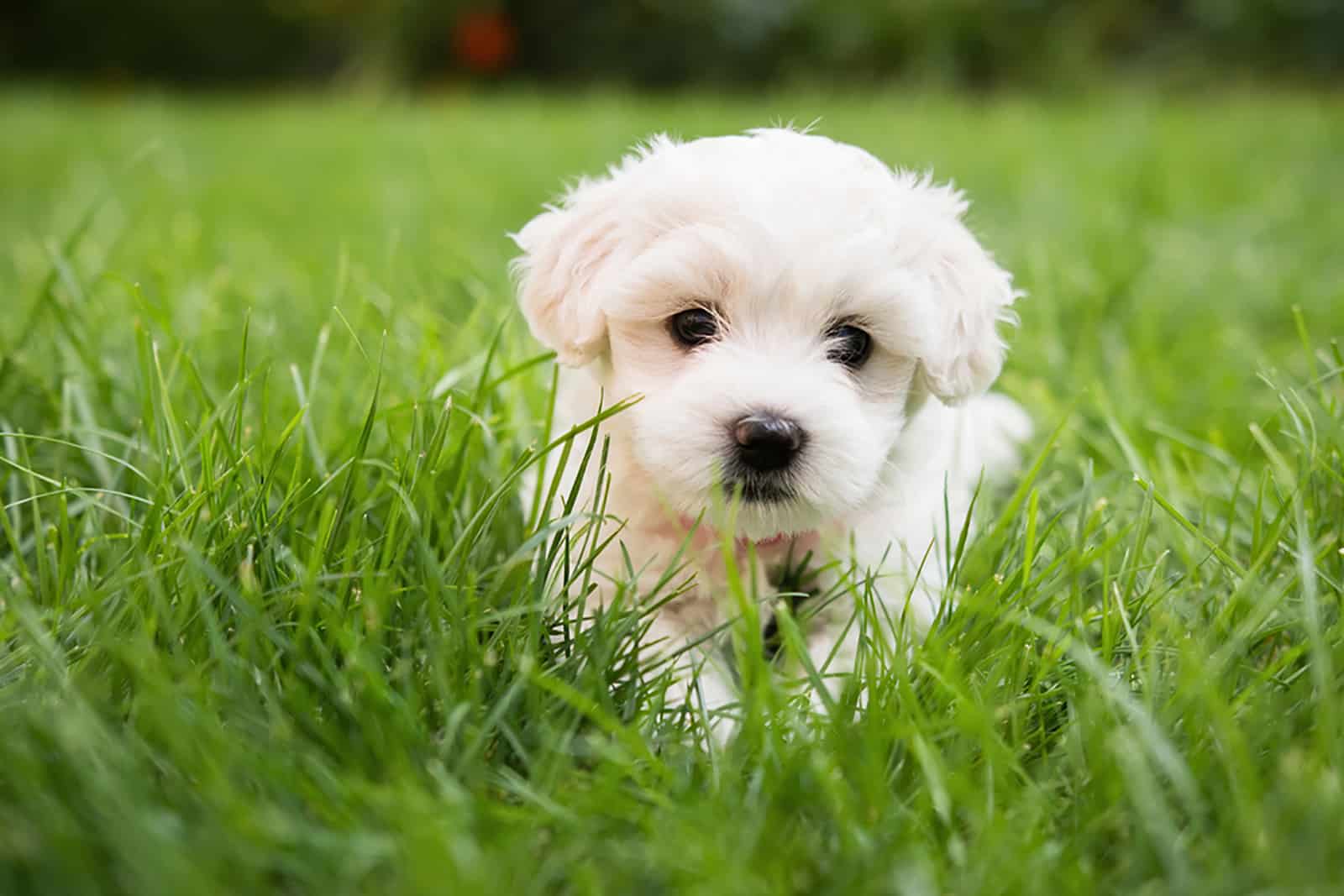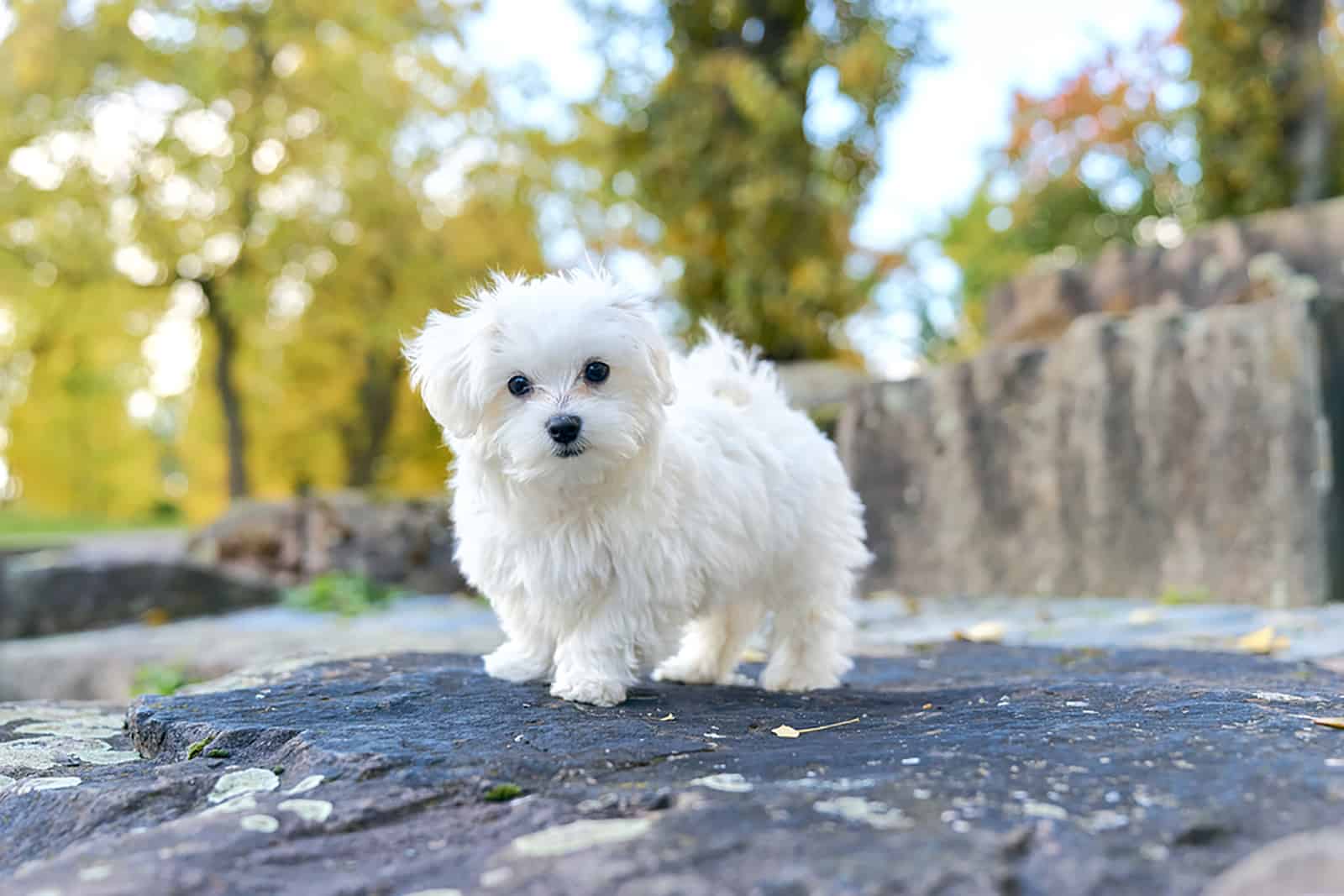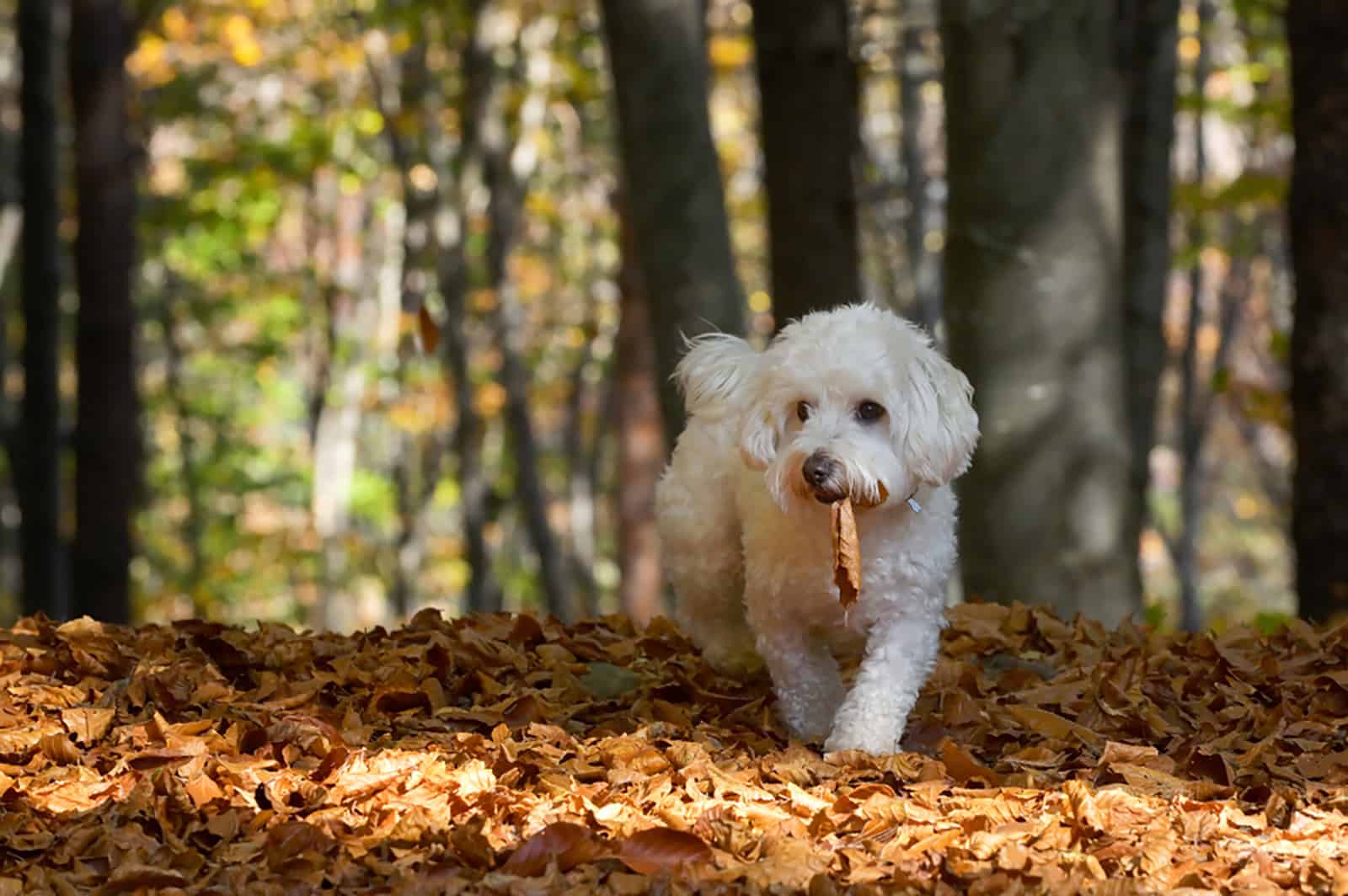Tiny but fearless, the Maltese is a dog that every dog lover would fall in love with! This little dog is playful and energetic, and you will never be bored with it.
Even if you have never had a dog before, the Maltese will make a great pet since this dog is obedient and adaptable.
In addition to being extremely gentle with their owners, the Maltese are also protective and will always be alert and will react by barking at unfamiliar people or noises.
When it comes to its physical appearance, all you probably know about the size of this dog is that it belongs to a group of smaller dog breeds.
Their size makes them the perfect dogs to pet and to hold in our laps all day long! If you intend to become the owner of this toy dog, it would be beneficial for you to know your puppy’s growth course.
This is why the following Maltese growth chart will greatly help you.
Maltese Growth Chart

In the chart below, we will show the typical growth of a Maltese puppy.
The weight of the Maltese pup in the following chart is expressed in ounces (16 ounces equals 1 pound), except for the adult weight, which is described in pounds.
[table id=633 /]
Sometimes, it is possible to notice deviations from the desired values. Still, they certainly should not be significant, especially with dogs as small as the Maltese.
This happens due to certain factors that can affect the growth of the Maltese, and we will say a little more about them later in the text.
These values correspond to both female and male Maltese. The ideal weight for both male and female Maltese is between four and six pounds.
Still, some Maltese dogs might weigh more. They might be perfectly healthy, but they are not allowed to participate in dog shows since their weight is not within the desirable range.
According to the AKC’s(American Kennel Club), official breed standard, purebred Maltese dogs should be between eight and ten inches tall.
Maltese Puppy Growth Chart With Developmental Stages

As seen in the previous chart, the weight of an adult Maltese usually varies between two and seven pounds. For this reason, the Maltese breed is one of the smallest dog breeds out there. The smallest, and the cutest, if you ask me!
During their development, Maltese go through certain stages in which, together with some other factors, their weight also changes.
Let’s look at the course of these development stages.
1. Birth To Four Weeks
This phase of development is called the I neonatal period. As we can see in the Maltese puppy weight chart, when they are first born, these puppies can weigh from 2.5 to 6.5 ounces.
When they are just born, puppies can’t hear anything, and their eyes are closed. In the first few weeks of development, the little Maltese slowly opens its eyes. In this period, the dog’s senses start to develop.
Baby teeth start to grow when Maltese puppies are around three weeks old. Puppies have 28 baby teeth, which will fall out later and be replaced by permanent teeth.
When the puppy’s teeth grow, stronger drooling is noticeable, as well as unpleasant breath.
By the end of this first stage of development, your Maltese should be able to stand on its own and slowly explore its surroundings.
A four-week-old Maltese puppy should weigh between seven and 24 ounces, depending on his birth weight.
2. Four Weeks To Seven Weeks
This is the so-called weaning period for Maltese dogs.
During this period, the little Maltese dogs still depend on their mother. At this time, the puppy’s socialization with the mother and other puppies from the same litter begins.
Also, in this period, Maltese puppies can slowly start to socialize with people, too, but it is necessary to be careful. The Maltese are still tiny and should not see too many people.
A six-week-old Maltese weighs from nine to 32 ounces and can weigh from 10 to 35 ounces at seven weeks of age.
The puppy should not be entirely separated from the mother yet. In this period, starting with the transition to solid food is preferable.
Switching from mother’s food to solid food is not entirely easy for puppies, therefore, this should be done slowly and with understanding. Also, not all puppies are ready to switch to solid food simultaneously.
One Maltese in a litter may be ready to transition, while others may not yet be. In the beginning, making puppy mush for your little Maltese would be a good idea.
This means adding a little milk or warm water to the dry food to make it easier for the puppy to digest.
As time goes by, you should reduce the amount of water or milk you add. As time passes, milk and water should be eliminated entirely, and then the puppy begins to eat only solid food.
For puppies this small, feeding them at least three times a day would be ideal.
3. Eight Weeks To 11 Weeks

This phase is a period of socialization for the Maltese puppy. The dog must receive support and understanding during this period. When puppies are this small, they can develop various fears and anxiety.
This is an ideal time to begin with the basic dog training, which is best done with the positive reinforcement method.
Much of what your Maltese learns during this period will be reflected in its behavior when it grows up. Therefore, this is the time when you need to lay the foundation to raise an obedient and well-behaved puppy.
In terms of weight, an eight-week-old Maltese can weigh anywhere from 11 to 39 ounces, while the ideal weight range for an 11-week-old Maltese ranges from 19 to 49 ounces.
4. Three Months To Six Months
At three months old, Maltese weigh about two pounds on average. During this period, the puppy grows permanent teeth, so you will most likely notice that the dog is chewing and biting everything.
To prevent your Maltese from chewing things around the house, buying chewing toys might be helpful. These toys will entertain the dog and ease the discomfort caused by teething.
This is also the period of sexual awaking of Maltese dogs. If you notice your female dog is suddenly humping, this could signify that your Maltese is sexually mature!
If you don’t want your puppy to reproduce, it would be good to think about spaying or neutering the dog during this period.
When a Maltese is six months old, it weighs four to seven pounds and stands between eight and 10 inches tall. So, at this point, your Maltese will have already reached its adult size.
5. Six Months To 12 Months
This is the period of adolescence for Maltese, which means that you will probably notice your pooch slowly forming its own attitude. In some situations, he may act as if he is actually the boss, not you.
If the dog behaves stubbornly and refuses obedience, it is important to show him dominance. Dogs that are not set boundaries become nervous dogs that can even show aggressive outbursts.
When Malteser is a year old, this is a fully grown dog. However, he can still occasionally show some immature behavior. With a little patience and quality training techniques, it is still not too late for your dog to become obedient and tame.
You can find some helpful advice in our article on how to make a perfect puppy schedule.
What Factors Affect Maltese’s Growth?

As we have already mentioned, there is no particular difference in weight between female and male Maltese. So, gender is not an essential factor in Maltese weight.
However, some other factors are essential and significantly affect how much your adult Maltese will weigh.
Let’s take a look at those factors.
Genetics
If you have seen the parents of your Maltese, there is a high probability that this is what your Maltese will look like when he grows up. Genetics is a crucial factor that determines Maltese size.
Of course, in some cases, puppies do not have to be exactly the same weight and height as their parents – some Maltese may be bigger than their parents.
When you look at the health data of your future puppy’s parents, you can find out whether there is any genetic predisposition for a particular disease in your dog.
Similarly, when you look at your puppy’s parents, you can see how approximately your puppy will look in the future.
Nutrition
Food, in general, greatly influences the dog’s health and quality of life.
Did you know that when you feed your dog high-quality food, you may be directly working to extend his lifespan? With proper nutrition, you ensure that your puppy spends many fun and beautiful years with you!
Nutrition also has a direct impact on the growth of your Maltese. Suppose you leave dog food everywhere for your Maltese and ignore his daily calorie intake. In that case, there is an excellent chance that your dog will develop obesity.
Obesity in dogs can lead to numerous other health problems. On the other hand, if you don’t feed your dog regularly enough, or the puppy refuses to eat, it will show in the puppy’s weight.
You will quickly notice a halt in development in your Maltese if it is not fed enough.
The perfect dog food for Maltese dogs should be highly nutritious and low in additives and fillers. We advise you to look at our list of suggestions for quality food for Maltese.
Furthermore, treats are something every dog loves, but you need to be careful with them with Maltese.
You should not overdo it with the quantities. We also have some suggestions for the best treats for Maltese, so, take a look!
In some cases, when a dog refuses food, he may not have any health problems, but simply does not like certain dog food. If you are thinking of changing your Maltese’s diet, it would be best to consult a veterinarian.
Activity Level
Maltese can be described as a lazy dog breed in terms of exercise. This means that, despite this dog being so energetic, it does not require so much activity.
Moreover, suppose your Maltese gets used to not exercising at all with time passing. In that case, it might even stop wanting to go walking or playing.
This should not be allowed by no means.Exercise is equally crucial for all dogs, even though some need more exercise than others. Activity level is an essential factor that affects the Maltese growth rate.
Exercising a Maltese does not imply any spectacular activity. For such a small dog, a regular walk will be enough.
A Maltese with regular daily physical activity will have better blood circulation and stronger muscles. Also, with regular exercise, you will regulate the weight of your Maltese.
Some dogs let you know on their own that it’s time to go outside. If this is not the case with your Maltese, be the one to encourage your puppy to exercise.
Heath In General
Health certainly affects the growth and development of the Maltese. If the dog has certain health problems, this can be reflected in its weight.
The first thing that all dog owners need to do is to ask the breeder for proof of genetic testing of the dog’s parents.
If you are looking for a decent place to buy a Maltese puppy, take a look at our list of best Maltese breeders in the States.
Dogs can develop various health conditions, but hereditary diseases are something to pay the most attention to.
Of course, even if you have received confirmation that your puppy’s parents are perfectly healthy, this does not mean that your puppy will not get sick from some other disease at some point in its life.
Therefore, regular vet visits should definitely be part of your care for your pet.
What Is Maltese Lifespan?

The average lifespan of Maltese ranges from 12 to 15 years. So, these dogs live quite a long time, which is what we all want – to spend as many beautiful years as possible with our pets!
However, the average life expectancy does not mean that every Maltese will live to these years. That is why it is essential to take care of the health of our dogs, their diet, exercise, and regular visits to the vet.
If you notice that your dog has lost weight, has a decreased appetite, or is acting weird all of a sudden, this could indicate that your dog is sick.
Let’s look at some of the health issues in Maltese dogs.
1. Reverse Sneezing
Reverse sneezing is not such a rare phenomenon among dogs. Contrary to a normal sneeze, where the air is pushed out, in a reverse sneeze, the dog sucks air into the respiratory tract.
Many dog owners are pretty surprised when they notice this kind of sneezing in their pets.
Reverse sneezing occurs for various reasons, such as strong perfumes, pollen, too-tight necklaces, or more significant physical activity. It would be good if the dog owner could determine precisely the reverse sneezing trigger is in his dog.
Reverse sneezing is usually not dangerous. However, if the reverse sneezing lasts too long and occurs frequently, it is necessary to consult a veterinarian.
2. Hypoglycemia
Hypoglycemia is a condition when the dog’s blood sugar level is too low.
Some of the most common symptoms you can notice in a dog with hypoglycemia are weakness, blurred vision, disorientation, shaking, and increased appetite.
If these symptoms are noticed, it is necessary to contact the veterinarian right away. The veterinarian will immediately take the steps required to increase the dog’s blood sugar level, after which he will assign further treatment.
Most often, a dog’s diet change is recommended to reduce the risk of a severe health condition recurrence in a dog caused by hypoglycemia.
3. Progressive Retinal Atrophy
Progressive Retinal Atrophy in dogs is a hereditary disease of the retina. In severe cases, this disease can cause complete blindness in the dog.
Some dogs start to show symptoms of the disease when they are still very young, while in some other dogs, the condition is noticeable only when they are pretty old.
The most common first symptom is the loss of night vision in dogs. You may notice the dog being disoriented and bumping into things when it’s dark or dimmed.
Progressive Retinal Atrophy is an incurable disease. It is only possible to treat this disease with antioxidants that prolong the complete blindness of the dog.
4. Shaker Syndrome
The Shaker Syndrome is also known as the White Dog Shaker Syndrome, since it often shows in white dog breeds.
This syndrome implies a condition when the processes in the dog’s body that should enable balance, coordination, and posture control do not function properly.
A dog with this syndrome will shake uncontrollably and appear frightened. Some dogs can also act disoriented.
Certain emotions can cause your Maltese to shake, such as excitement, stress, fear, etc.
To diagnose shaking syndrome in a dog, the veterinarian must perform thorough examinations. These examinations usually include a physical exam, blood work, and a neurological exam.
FAQs

Can A Maltese Weigh 12 Pounds?
There might be Maltese dogs that weigh 12 pounds. However, this is not a good thing. As we have mentioned, the ideal weight for a Maltese dog goes from four to six pounds.
Anything below this range is considered underweight, and above this range is considered overweight.
Being overweight in Maltese can occur for several reasons. Maybe it’s poor breeding, maybe your Maltese is getting too much food, or maybe it’s getting almost no exercise.
A Maltese that weighs more than the breed standard suggests cannot participate in dog shows. An overweight Maltese can be in good health, but you should ensure that your puppy’s weight does not deviate too much from the standard.
What Age Will My Maltese Be Full Grown?
A Maltese is considered an adult at around six to eight months of age. So, these dogs mature quite early and achieve their adult weight and height at this early age.
Smaller dogs generally grow significantly faster than larger dogs. Some larger dogs continue to develop until they are one year old, and for some it takes even longer!
How Much Should A 4 month Old Maltese Weigh?
A four month old Maltese puppy should weigh from 2.25 to 4.5 pounds.
The weight will vary from how much the Maltese weighed when he was born.
Also, not all dogs grow in the same way, even though they are the same breed. Some will eat more, some less. Also, some puppies will be genetically predisposed to be larger than other dogs of the same breed.
How Tall Should A Maltese Be At 6 Months?
Maltese are usually eight to ten inches tall at six months of age, and this means that Maltese already reach their adult size at the period of six months.
While large dogs usually grow much longer, smaller dogs like the Maltese mature early. Thus, most Maltese will also reach their adult weight at the age of six months.
If your puppy is slightly smaller than we have stated, this does not mean you should immediately worry. However, if time passes and the size of the dog does not change at all, in that case you should contact the veterinarian. It is possible that your
Maltese has a growth delay.
Final Thoughts
If you intend to become a Maltese owner, you probably know this dog is tiny. Perhaps this is even the decisive factor why you decided on a Maltese – a dog this little will be able to live in a smaller house or apartment!
However, it is not enough to know that this dog belongs to a group of small dogs. Every future dog owner must be familiar with the expected size of their Maltese.
This is why we believe this Maltese growth chart will be handy to you. By following this chart, you will be able to compare your puppy’s weight with the desired weight for each stage of its growth.
These values are general and, if you notice minor deviations, this does not necessarily mean that your Maltese is not developing correctly.
As we have seen, various factors will influence the growth and development of Maltese. Some factors, such as genetics, cannot be influenced by anyone.
But, we can provide our Maltese with a pleasant environment, quality food, and regular visits to the vet.
By taking care of the growth and weight of our dogs, we also take care of their overall health and directly affect the lifespan of our furry friends.
Read Next:
• Pomeranian Growth Chart – How Big Can Pomeranians Get?
• Teacup Maltese: A Tiny White Pooch To Love
• Shih Poo Growth Chart For The Toy And Standard Size
